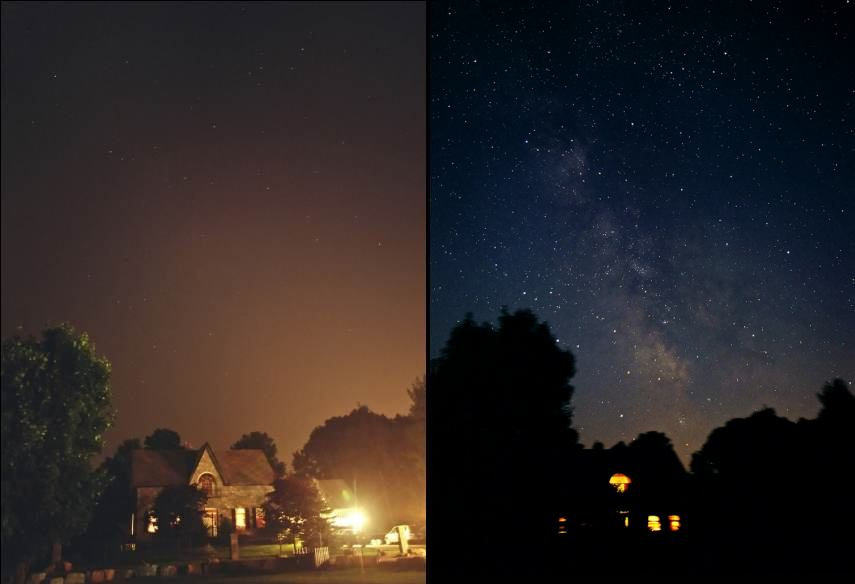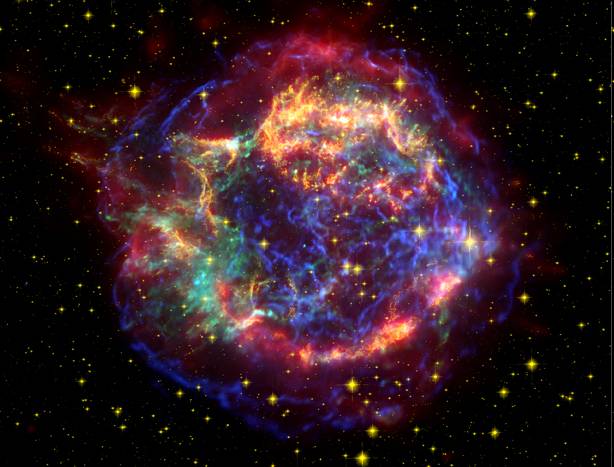For most of human history, the night sky demanded our attention. The shape-shifting Moon, wandering planets, pointillist stars, and occasional comet enchanted our sensibilities while inspiring diverse tales of origin. The Milky Way, in particular, exerted a powerful presence on our distant ancestors. Rippling across the firmament, this irregular band of ghostly light evoked myriad myths of life and death among the stars. In 1609, Galileo Galilei pointed his telescope heavenward and discovered that the Milky Way is “nothing but a congeries of innumerable stars grouped together in clusters.” Fast forward 400 years to the present day, and we find that the Milky Way has all but disappeared from our collective consciousness. Where did it go?
For 25 years as an astronomy educator, I have informally polled hundreds of students, teachers, and the general public regarding their awareness of the night sky. Invariably, no more than 25 percent have ever seen the Milky Way with their own eyes. For city dwellers, this is completely understandable. Unless properly shielded, the artificial lighting from municipal, commercial, and residential sources will spill into the sky and overwhelm the diffuse band of luminescence that is the hallmark of our home galaxy. The recent video “The City Dark” produced by POV underscores the disruptive aspects that artificial lighting can produce on the life cycles of certain animals – and even upon ourselves (see http://www.pbs.org/pov/citydark/).

View from Goodwood, Ontario before and after a power blackout (Courtesy Todd Carlson)
For residents of small towns well away from large cities (such as my own hometown of Rockport, MA), it is much easier to find dark “sanctuaries” where the Milky Way can be spied in all its exquisite beauty. Yet when I poll Rockport’s sundry inhabitants about having ever seen the Milky Way, I still get a measly 25% positive response. What’s going on here?
Is it that they don’t care about astronomy and the night sky? I would have to say that such astronomical indifference is not typical. Most people in conversations with me will volunteer their fascination for the planets, stars, and the exotica that our universe provides in abundance – from exoplanets to pulsars, black holes, dark matter, and dark energy. Images from our great space telescopes have also revealed to the casual viewer many marvels of the Milky Way Galaxy, other nearby galaxies, and the remote galaxian cosmos. Recently, stunning composite images of X-ray, visible, and infrared emission from regions of cosmic tumult have vivified the many powerful dramas that continue to unfold upon the galactic stage.

Supernova remnant Cassiopeia A, as observed 325 years after a massive star exploded. (X-ray: blue), (Visible: green), (Infrared: red) – NASA
Yet, despite popular enthusiasm for the wonders of space, most people still do not bother to find a dark site and witness the source of these wonders for themselves. Otherwise, my informal polling would have indicated that they knew about the Milky Way as a naked-eye marvel. I suppose it comes down to the delivery of experiences. We have grown accustomed to having our experiences conveyed to us in familiar, safe, and readily-accessible packages – be they books, magazines, television programs, planetarium shows, or interactive websites.
Regarding the latter, consider the Zooniverse online portal (http://www.zooniverse.org), where anybody with an internet connection can contribute to authentic scientific research. With just your eyes and hands, you can search for exoplanets around distant suns, trace out star-blown bubbles in our galaxy’s interstellar medium, and categorize the types of galaxies that dwell in deep space. To date, close to a million people have contributed to these and sundry other online scientific investigations.
Then there are the mobile apps. One popular type of app, in particular, has brought millions more people closer to the night sky. Google Sky Map, Droid Sky View, The Night Sky, and other interactive planetarium simulators enable a smartphone user to point the phone in any direction and see what stars and constellations are located there. Most of these simulators show the Milky Way as a hazy band, thus cueing the viewer to its existence. But does that mean that more people are making the effort to find dark sites for smartphone-aided star gazing? Is participation in amateur astronomy clubs on the rise as a result? And are star parties at our national parks surging with attendees? My very limited research on these questions suggests that – yes – ever more people are seeking the sublime wonders of dark skies. Whether such interactive apps are responsible for these trends remains unknown. Still, I remain optimistic.
Perhaps our electronic addictions and virtual realities will ultimately re-introduce ourselves to the unembellished Milky Way – and to other direct experiences that Nature so generously provides. We may be plugged-in as never before, but still we hunger for authentic interactions with the mysterious ways of Nature. Towards these ends, I urge that we re-double our efforts to preserve the dark night sky through the advocacy of properly-shielded lighting and the establishment of dark-sky sanctuaries. To help in these regards, please visit the International Dark Sky Society’s webpage at http://www.darksky.org.
William H. Waller earned his Ph.D. in astronomy at the University of Massachusetts. He has since carried out diverse programs in scientific research and education at the University of Washington, NASA’s Goddard Space Flight Center, Tufts University, and the Museum of Science – Boston. He is author of The Milky Way — An Insider’s Guide and co-editor of The Galactic Inquirer – an e-journal and forum on the topics of galactic and extragalactic astronomy, cosmochemistry, astrobiology, and the prospects for interstellar communication. Bill’s current day job involves teaching high-school courses in physics and astronomy in his hometown of Rockport, MA. He can be reached at williamhwaller@gmail.com


can’t leave this blank…
Great article Bill! I for one get discouraged about how difficult it is to find a truly dark sky site to do some star gazing. Light pollution is such a huge problem to tackle. I really like the concept of new technology (smartphone apps, etc) actually bringing us closer to this end and is something I’ve never considered before! As a lighting designer, I feel strongly about lighting ordinances and fixture ratings (less glare & uplight) and am striving to make people aware of these issues. Here is a link to my blog on artificial lighting and dark skies. http://www.lightpositive.com/2013/09/keeping-our-skies-dark/
Hopefully the more aware people are, the faster we will make changes!
The ramification of a mere 150 years where humans have been reduced to a non-interactive state of cosmic consciousness by the combined effects of industrial light pollution has undermined our very state of being. Our evolution of well over a hundred millennia is written in the Pleistocene era caves of northern Europe, the Australian outback, and the American southwest as a testament to our sense of awe and wonder at the visible and returning night sky. It is the very foundation of mankind’s attempt to understand his place in the grand universe . Our mythologies, cultural mores, and spiritual and religious aspirations were the means by which our species strove to make sense of his existential understanding and / or lack thereof and what is meant by being human.
Philosophers , mystics, sages, shamans, kings and priests all arose in deep reflections and meditations to ponder such questions which a visible and bountiful night sky seared into their inquiring mind by its very presence and awe inspiring grasp of our intuitive quest for a sense of connectedness.
Thus, it is my conviction and stated belief that despite the advancement and scientific achievements of the current era , where success is defined as being more plugged into an electronic paradigm of ever increasing and discordant human synergies, our true sense of self and ‘connectedness’ has been lost resulting in an alienation from our ‘consciousness roots’ established from eons ago with drastic effects for both our survival and harmony as one species existing on a pale blue dot in a cosmic ocean of unfathomable dimensions.
I suggest that a serious inquiry into this lost wonder is a very legitimate undertaking for our very survivability may hang in the balance if we fail to address our diminishing cosmic consciousness.
“Astronomy compels the soul to look upwards and leads us from this world to another”.
Plato, Greek Philosopher, 429–347 B.C.E
“Dwell on the beauty of life. Watch the stars, and see yourself running with them.”
Marcus Aurelius in Meditations
Roman Emperor and Stoic Philosopher, 161 to 180 AD
Thank you Patrick for your deeply humanistic perspectives on the importance of connecting with the cosmos. You rekindle the question of what we are losing when we replace direct experiences with virtual experiences? Perhaps others might have some insights (and even solutions) in these regards?
Not often do I have the pleasure to hear somebody else explain just how thoroughly we humans have distanced themselves from our place in nature. Our singular major evolutionary advantage, an ability to create tools which eventually positioned us as the apex predator of the entire world, has simultaneously caused us to completely remove ourselves from balance with other life on the planet, to the extent that we feel almost godly, ruling over other life, and no longer feeling sympathy for it. Increasing exponentially in the last few centuries, we’ve finally lost all care for our environment, after all, we humans are so far above it that we could never truly be effected by the destruction of something so insignificant compared to ourselves. Or so we thought, that is.
Our own collective narcissism, and not much more than that, is why we no longer awe at the grass we stand on, or the tiny insects and bacteria. or the mighty redwoods with expansive root systems the size of football fields, or the biome we call Earth, or even the beautiful and once captivating stars.
You present a cogent and exacting summary of the repercussions that a departure from our nature-centered origins have wrought upon the biosphere and our sentient consciousness. In the annals of time, it is a recent phenomenon but that does not in any manner dismiss the adverse severity of its effects both on the human condition and the sustaining capacity of the web of life.
The ancients stood in awe of the majesty of the natural world. Industrialization has interceded in the life matrix where the bounties of nature are monetized for private gain. The effects of light pollution are an ancillary result of this very condition. As astronomers, perhaps the calling to observe the night sky in all its splendor is our racial ethos manifesting its yearning to all that we have lost and resurrecting our hope to all that we have yet to gain.